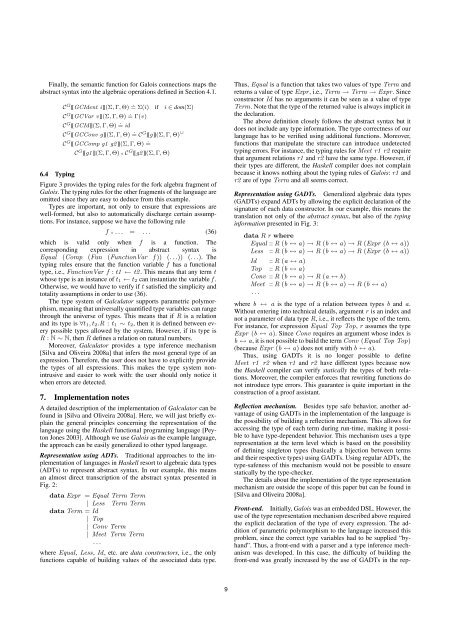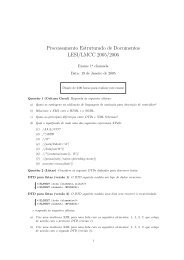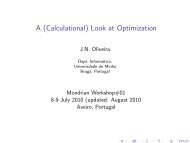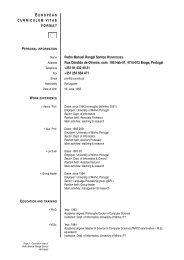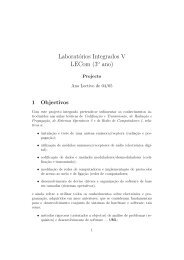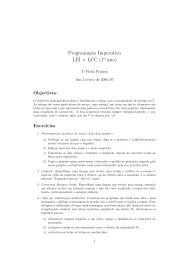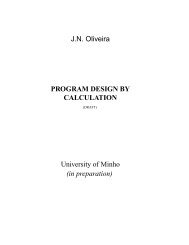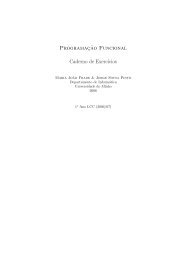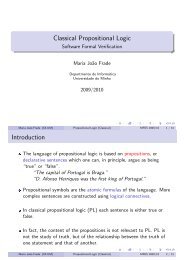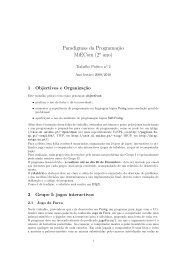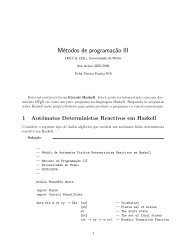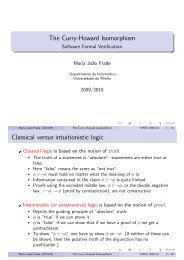Galois
Galois
Galois
Create successful ePaper yourself
Turn your PDF publications into a flip-book with our unique Google optimized e-Paper software.
Finally, the semantic function for <strong>Galois</strong> connections maps the<br />
abstract syntax into the algebraic operations defined in Section 4.1.<br />
6.4 Typing<br />
C G [[GCIdent i]](Σ, Γ, Θ) . = Σ(i) if i ∈ dom(Σ)<br />
C G [[GCVar v]](Σ, Γ, Θ) . = Γ(v)<br />
C G [[GCId]](Σ, Γ, Θ) . = id<br />
C G [[GCConv g]](Σ, Γ, Θ) . = C G [[g]](Σ, Γ, Θ) ∪<br />
C G [[GCComp g1 g2 ]](Σ, Γ, Θ) . =<br />
C G [[g1 ]](Σ, Γ, Θ) ◦ C G [[g2 ]](Σ, Γ, Θ)<br />
Figure 3 provides the typing rules for the fork algebra fragment of<br />
<strong>Galois</strong>. The typing rules for the other fragments of the language are<br />
omitted since they are easy to deduce from this example.<br />
Types are important, not only to ensure that expressions are<br />
well-formed, but also to automatically discharge certain assumptions.<br />
For instance, suppose we have the following rule<br />
f ◦ . . . = . . . (36)<br />
which is valid only when f is a function. The<br />
corresponding expression in abstract syntax is<br />
Equal (Comp (Fun (FunctionVar f )) (. . .)) (. . .). The<br />
typing rules ensure that the function variable f has a functional<br />
type, i.e., FunctionVar f : t1 ← t2 . This means that any term t<br />
whose type is an instance of t 1 ← t 2 can instantiate the variable f .<br />
Otherwise, we would have to verify if t satisfied the simplicity and<br />
totality assumptions in order to use (36).<br />
The type system of Galculator supports parametric polymorphism,<br />
meaning that universally quantified type variables can range<br />
through the universe of types. This means that if R is a relation<br />
and its type is ∀t 1, t 2.R : t 1 ∼ t 2, then it is defined between every<br />
possible types allowed by the system. However, if its type is<br />
R : N ∼ N, then R defines a relation on natural numbers.<br />
Moreover, Galculator provides a type inference mechanism<br />
[Silva and Oliveira 2008a] that infers the most general type of an<br />
expression. Therefore, the user does not have to explicitly provide<br />
the types of all expressions. This makes the type system nonintrusive<br />
and easier to work with: the user should only notice it<br />
when errors are detected.<br />
7. Implementation notes<br />
A detailed description of the implementation of Galculator can be<br />
found in [Silva and Oliveira 2008a]. Here, we will just briefly explain<br />
the general principles concerning the representation of the<br />
language using the Haskell functional programing language [Peyton<br />
Jones 2003]. Although we use <strong>Galois</strong> as the example language,<br />
the approach can be easily generalized to other typed language.<br />
Representation using ADTs. Traditional approaches to the implementation<br />
of languages in Haskell resort to algebraic data types<br />
(ADTs) to represent abstract syntax. In our example, this means<br />
an almost direct transcription of the abstract syntax presented in<br />
Fig. 2:<br />
data Expr = Equal Term Term<br />
| Less Term Term<br />
data Term = Id<br />
| Top<br />
| Conv Term<br />
| Meet Term Term<br />
. . .<br />
where Equal, Less, Id, etc. are data constructors, i.e., the only<br />
functions capable of building values of the associated data type.<br />
Thus, Equal is a function that takes two values of type Term and<br />
returns a value of type Expr, i.e., Term → Term → Expr. Since<br />
constructor Id has no arguments it can be seen as a value of type<br />
Term. Note that the type of the returned value is always implicit in<br />
the declaration.<br />
The above definition closely follows the abstract syntax but it<br />
does not include any type information. The type correctness of our<br />
language has to be verified using additional functions. Moreover,<br />
functions that manipulate the structure can introduce undetected<br />
typing errors. For instance, the typing rules for Meet r1 r2 require<br />
that argument relations r1 and r2 have the same type. However, if<br />
their types are different, the Haskell compiler does not complain<br />
because it knows nothing about the typing rules of <strong>Galois</strong>: r1 and<br />
r2 are of type Term and all seems correct.<br />
Representation using GADTs. Generalized algebraic data types<br />
(GADTs) expand ADTs by allowing the explicit declaration of the<br />
signature of each data constructor. In our example, this means the<br />
translation not only of the abstract syntax, but also of the typing<br />
information presented in Fig. 3:<br />
data R r where<br />
Equal :: R (b ↔ a) → R (b ↔ a) → R (Expr (b ↔ a))<br />
Less :: R (b ↔ a) → R (b ↔ a) → R (Expr (b ↔ a))<br />
Id :: R (a ↔ a)<br />
Top :: R (b ↔ a)<br />
Conv :: R (b ↔ a) → R (a ↔ b)<br />
Meet :: R (b ↔ a) → R (b ↔ a) → R (b ↔ a)<br />
. . .<br />
where b ↔ a is the type of a relation between types b and a.<br />
Without entering into technical details, argument r is an index and<br />
not a parameter of data type R, i.e., it reflects the type of the term.<br />
For instance, for expression Equal Top Top, r assumes the type<br />
Expr (b ↔ a). Since Conv requires an argument whose index is<br />
b ↔ a, it is not possible to build the term Conv (Equal Top Top)<br />
(because Expr (b ↔ a) does not unify with b ↔ a).<br />
Thus, using GADTs it is no longer possible to define<br />
Meet r1 r2 when r1 and r2 have different types because now<br />
the Haskell compiler can verify statically the types of both relations.<br />
Moreover, the compiler enforces that rewriting functions do<br />
not introduce type errors. This guarantee is quite important in the<br />
construction of a proof assistant.<br />
Reflection mechanism. Besides type safe behavior, another advantage<br />
of using GADTs in the implementation of the language is<br />
the possibility of building a reflection mechanism. This allows for<br />
accessing the type of each term during run-time, making it possible<br />
to have type-dependent behavior. This mechanism uses a type<br />
representation at the term level which is based on the possibility<br />
of defining singleton types (basically a bijection between terms<br />
and their respective types) using GADTs. Using regular ADTs, the<br />
type-safeness of this mechanism would not be possible to ensure<br />
statically by the type-checker.<br />
The details about the implementation of the type representation<br />
mechanism are outside the scope of this paper but can be found in<br />
[Silva and Oliveira 2008a].<br />
Front-end. Initially, <strong>Galois</strong> was an embedded DSL. However, the<br />
use of the type representation mechanism described above required<br />
the explicit declaration of the type of every expression. The addition<br />
of parametric polymorphism to the language increased this<br />
problem, since the correct type variables had to be supplied “byhand”.<br />
Thus, a front-end with a parser and a type inference mechanism<br />
was developed. In this case, the difficulty of building the<br />
front-end was greatly increased by the use of GADTs in the rep-<br />
9


